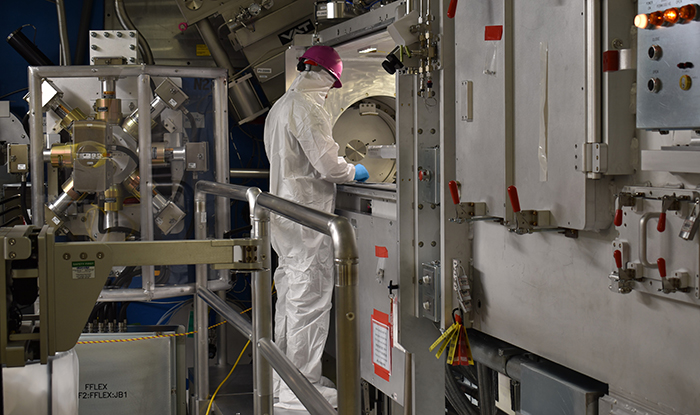Energetic Laser Helps Test Weapon Survivability
The following is an excerpt from an article by Dan Linehan in the May 2019 issue of Science & Technology Review.
 A technician at NIF prepares to load a sample into a specialized holder that will extend into the 10-meter-diameter target chamber for testing. Credit: Brent Blue
A technician at NIF prepares to load a sample into a specialized holder that will extend into the 10-meter-diameter target chamber for testing. Credit: Brent Blue Established after the halt of underground nuclear testing, the Stockpile Stewardship Program is a critical element of the National Nuclear Security Administration’s mission to ensure the safety, security, and effectiveness of the U.S. nuclear deterrent. As part of this program, scientists are tasked with guaranteeing nuclear weapons’ survivability—that is, ability to function—under hostile conditions, such as those that could result from a pre-emptive strike by an adversary, or when a conventional war may be fought in a nuclear environment.
In the absence of nuclear testing, high energy density (HED) facilities, such as Lawrence Livermore National Laboratory’s National Ignition Facility (NIF), have become a key tool for testing the survivability of nuclear weapon components. NIF allows researchers to subject nonnuclear parts, such as electronics and other materials, from weapon systems to intense radiation from x rays and neutrons and to probe material properties at extreme pressures and temperatures—conditions that mimic what systems may face in a real-world nuclear environment.
Brent Blue, the National Security Applications program manager at NIF, says, “Survivability is a chess game. The moves an opponent will make are unknown as are their capabilities. Trying to predict what an adversary might do now, let alone 30, 40, or 50 years out, during the lifetimes of these systems, is incredibly challenging. An effective survivability strategy requires one to account for myriad possible ‘what-if’ scenarios both now and in the future.”
Blue is part of a team at NIF that is implementing innovative methods for improving survivability experiments. For example, new target designs are serving as more intense sources of neutrons and x rays for maximizing the energy fluence through a test sample. In addition, specialized systems have been implemented for fielding samples closer to radiation sources, and novel diagnostics are recording essential data for determining how test materials are affected. These capabilities are providing new insight into weapon systems’ durability and enhance several national security programs.
To read the full story, go to Science & Technology Review.
—Dan Linehan
Follow us on Twitter: @lasers_llnl



